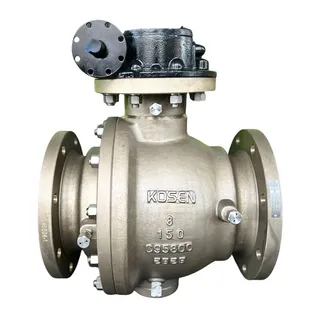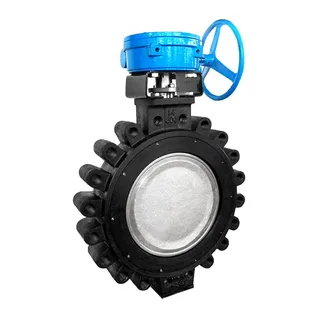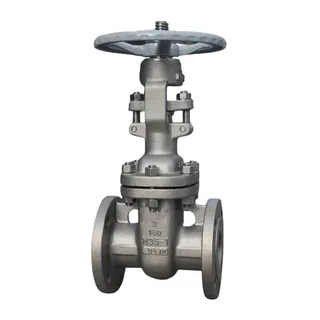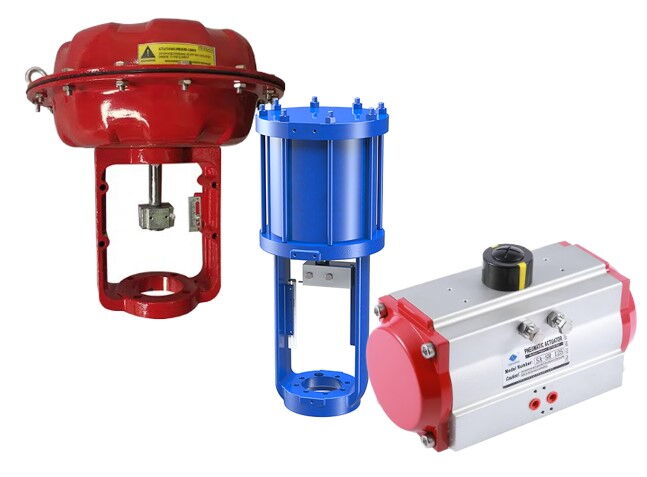
Pneumatic actuators are vital components in industrial automation, widely utilized in fluid control, valve regulation, and process automation. These actuators convert compressed air into mechanical motion to regulate fluid flow and maintain operational efficiency. Pneumatic actuators are classified into single-acting and double-acting types, each offering distinct features suited for specific applications. Single-acting actuators provide simple, cost-effective solutions for automatic resetting, while double-acting actuators offer higher precision and flexibility for more demanding applications. This article explores the working principles, types, advantages, disadvantages, and maintenance of pneumatic actuators, providing a comprehensive understanding of their role in industrial systems.
Pneumatic actuators are core components of industrial automation systems, widely used in fluid control, valve regulation, and production process automation. They are especially crucial in industries where safety and reliability are critical. Pneumatic actuators work by using compressed air to drive the opening and closing of valves, thereby regulating fluid flow and ensuring the stability and efficiency of production processes. Depending on their working principles, pneumatic actuators are classified into single-acting and double-acting types. This article will delve into the working principles, features, applications, advantages and disadvantages, as well as maintenance of these two types of pneumatic actuators, helping to understand their suitability and performance in various applications.
Pneumatic actuators convert the energy from compressed air into mechanical motion, which is used to open or close valves and regulate fluid flow. Based on their working modes, pneumatic actuators can be divided into single-acting and double-acting types, each suited for different operational needs and environments.
Single-acting pneumatic actuators have a simple design, typically consisting of a cylinder, piston, and spring. They work by applying air pressure to one side of the piston, which drives it along the cylinder's axis to open or close the valve. Specifically, when air pressure is applied to the piston, it compresses the spring and rotates the output shaft. When the air pressure is released, the spring's counteracting force returns the piston to its original position, causing the valve to revert to its preset default state. The advantages of single-acting pneumatic actuators include their simple structure, low cost, ease of maintenance, and automatic return to the preset position in the event of a loss of air pressure. This feature is particularly important in applications where high safety standards are required.
Double-acting pneumatic actuators provide greater control precision and flexibility compared to single-acting actuators, making them suitable for applications that require fast response times and high accuracy. In double-acting actuators, air pressure is applied to both ends of the cylinder via solenoid valves, driving the piston to move in both directions. When air pressure is applied to one end of the cylinder, the piston moves in one direction; when the pressure is reversed, the piston moves in the opposite direction, opening or closing the valve. Double-acting actuators are capable of providing higher thrust and better control precision, making them ideal for complex fluid regulation applications.
Pneumatic actuators come in various types, each designed for specific applications and featuring different characteristics and suitability conditions.
Diaphragm pneumatic actuators are the most commonly used type and are widely employed in standard valve control applications. Their basic structure includes a diaphragm, cylinder, and pushrod. When air pressure acts on the diaphragm, it deforms and pushes the rod, which opens or closes the valve. Diaphragm actuators are simple, cost-effective, and easy to maintain, offering high value for money.
Advantages: Diaphragm actuators are compact, lightweight, and ideal for applications with limited space. Compared to other types of actuators, diaphragm actuators are less expensive and suitable for large-scale industrial applications.
Disadvantages: Due to design limitations, diaphragm actuators provide less output force, making them more suitable for small to medium load applications. For applications requiring greater thrust or torque, diaphragm actuators perform less efficiently than other types.
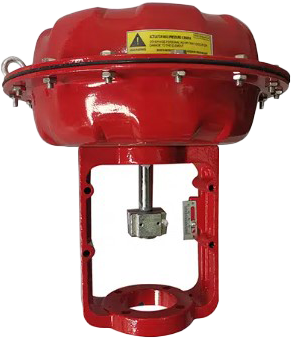
Piston pneumatic actuators use the linear motion of a piston within a cylinder to provide thrust. These actuators are ideal for applications requiring larger output forces, as they offer higher thrust and better control precision, making them suitable for regulating large-diameter or high-pressure valves.
Advantages: Piston actuators can generate stronger thrust, making them ideal for heavy-duty applications. Their sturdy construction allows them to perform well in harsh environments.
Disadvantages: Compared to diaphragm actuators, piston actuators have a more complicated structure and require more maintenance.

Rack-and-pinion pneumatic actuators use the interaction between a rack and a pinion to provide thrust. They are commonly used in applications that require high-precision control and large loads. These actuators offer high thrust, fast response, and excellent stability, making them suitable for high-pressure and high-temperature environments.
Advantages: Rack-and-pinion actuators offer very accurate control. They are suitable for large-diameter valves and high-pressure control.
Disadvantages: Rack-and-pinion actuators have a more complex design, requiring higher manufacturing precision and more demanding maintenance.
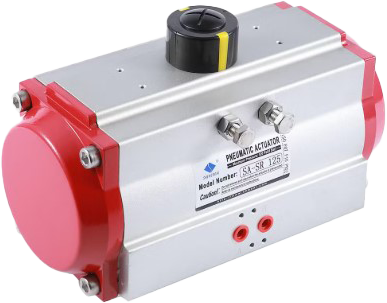
Pneumatic actuators have significant advantages, especially in automation and fluid control industries. They offer precise operation, rapid response, and high thrust, but also come with certain limitations.
Fast response time: Pneumatic actuators respond quickly to control signals, enabling rapid start and stop operations, ideal for applications that require quick actions and precise control.
High adaptability: Pneumatic actuators perform well in harsh environments such as high temperatures, humidity, and pressure, and are often used in hazardous locations since they do not generate sparks or electromagnetic interference.
High load capacity: Pneumatic actuators can provide significant thrust or torque, making them suitable for heavy-duty applications such as large valves or high-pressure systems.
Simple structure and low maintenance cost: Pneumatic actuators are relatively simple in design, compact, and easy to install and maintain. They have fewer moving parts, reducing the risk of mechanical failure. Maintenance mainly involves checking the air supply system and seals, thus lowering long-term operational costs.
High reliability: Due to their solid construction and simple working principles, pneumatic actuators are generally reliable, especially in systems that require continuous operation over long periods.
Dependence on the air supply: Pneumatic actuators rely on a stable air supply, which means that if the air supply is interrupted or pressure becomes unstable, the actuator may fail to operate. Therefore, a continuous and stable air supply is crucial.
Limited control precision: Although pneumatic actuators respond quickly, their control precision is generally lower than that of electric actuators, particularly in applications requiring fine adjustments. Pneumatic actuators typically provide discrete movements, while electric actuators offer more precise positioning.
Risk of air leakage: Pneumatic actuators may experience air leakage, especially after extended use, as seals age or become damaged. If leaks are not addressed promptly, system efficiency can decline, or equipment may fail.
Output force limitations: Despite providing significant thrust, pneumatic actuators are limited by air pressure and actuator size. In high-load or high-torque applications, other types of actuators, such as electric or hydraulic actuators, may be more suitable.
Environmental temperature effects: Performance may be affected by extreme temperatures. Very low temperatures can reduce the flowability of compressed air, while high temperatures can damage the actuator's seals, causing leakage or failure. Protective measures may be required in extreme temperature environments.
Pneumatic actuators are widely used in industrial control systems to carry out automated control tasks. Regular maintenance and care are crucial to ensure the efficient operation and extended service life of pneumatic actuators. Below are the key aspects of maintaining and caring for pneumatic actuators to ensure their reliability and performance.
Check Air Supply Pressure: The operation of pneumatic actuators relies on a stable air supply. Regularly check the air supply pressure to ensure the stability of the system. Both low and high air pressure can affect actuator performance.
Check Air Quality: Ensure that the air in the supply system is clean and free of impurities. Dirt, oil, or moisture entering the actuator can clog the airways and affect normal operation. Use air filters to remove moisture and contaminants from the air.
Seal Inspection: Seals (such as O-rings and gaskets) inside pneumatic actuators wear out or age over time. Regularly inspect their integrity. If any seals show cracks, aging, or wear, they should be replaced promptly.
Lubricate Seals: Proper lubrication can reduce seal wear and prevent excessive friction that may lead to seal failure. Use the appropriate lubricant and regularly lubricate the actuator's moving parts as recommended by the manufacturer.
Clean External Surfaces: Regularly clean the external surfaces of the pneumatic actuator to remove dust, oil, and contaminants. Excessive dust may enter the pneumatic system, causing blockages or damage. Use clean cloths and appropriate cleaning agents.
Lubricate Moving Parts: Inspect the actuator's moving parts, such as the piston and bearings, ensuring they are well-lubricated. Use the recommended lubricant to reduce wear and improve operational efficiency.
Motion Check: Ensure that the actuator moves smoothly without any jamming. Start the actuator and check its response time and motion stability during startup and stop cycles. Unusual noise, vibration, or erratic motion may indicate internal component wear or insufficient air supply.
Check Stroke Limiters: If the actuator is equipped with stroke limiters, verify their proper function to ensure they can correctly limit the actuator's stroke and prevent mechanical damage caused by excessive stroke.
Electrical Connection Check: If the pneumatic actuator is connected to an electrical control system (e.g., solenoid valves or position feedback devices), regularly check the electrical connections for integrity. Look for loose or damaged cables, as electrical issues can disrupt actuator operation.
Check Control Signals: Ensure that control signals are transmitted accurately, and that the control system sends the correct commands to the pneumatic actuator. Signal errors can cause the actuator to malfunction.
Check Ambient Temperature: The performance of pneumatic actuators is influenced by temperature. In extreme hot or cold environments, seals may age or fail. Ensure the actuator operates within the recommended temperature range and implement necessary insulation or heating measures to protect the device.
Check Humidity: High humidity environments can lead to moisture build-up inside the pneumatic system, affecting the actuator's performance. Install dryers or moisture filters to keep the system dry.
Calibration: For pneumatic actuators equipped with position feedback devices or sensors, perform regular calibration to ensure the actuator's stroke, position, and operational accuracy meet the required standards. By monitoring its operational parameters, potential performance issues can be identified early.
Performance Testing: Regularly conduct performance tests, including startup, stop, positioning accuracy, and response time, to ensure the actuator functions as expected. This helps in detecting and addressing any potential faults promptly.
Pneumatic actuators play a critical role in industrial automation control systems and have wide applications in various industries. When selecting the appropriate type of pneumatic actuator, consider the specific application requirements and working environment. Single-acting pneumatic actuators are suitable for applications requiring automatic resetting and low-cost solutions, while double-acting pneumatic actuators are ideal for high-precision control and heavy load situations. Regardless of the actuator type, regular maintenance and care ensure long-term stable operation, improving productivity and safety.

